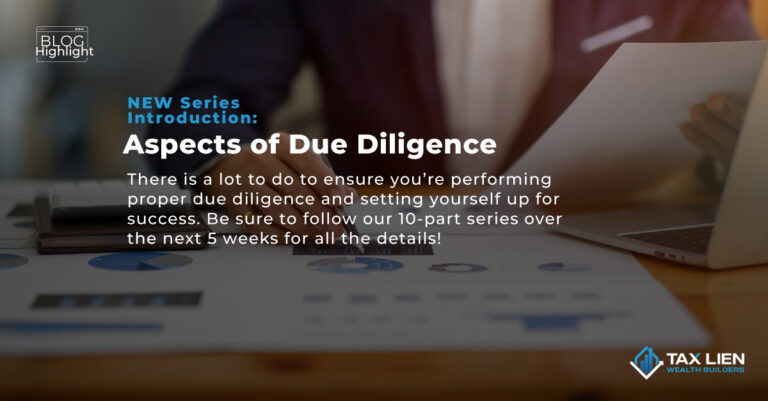How to Spot The Best Tax Lien Opportunities
The promise of high returns and the potential of acquiring properties at a fraction of their market value is often the magnet that draws investors into tax lien investing. However, it’s important to realize that tax lien investing involves more than surface-level numbers. ‘Not all that glitters is gold’ is as true in tax lien investing; you need to understand how to spot the best opportunities, not just the shiny ones.
So, how do you know when a tax lien is a smart investment? It starts with the property itself. The potential lies in the property, not just in the lien. Say you’re browsing through a list of tax liens and see one on a vacant lot in a not-so-great neighborhood. It’s cheap ; however, you spot a lien on a well-maintained single-family home in a growing area. While the former looks more affordable, the goal is not just to buy the lien; it’s to make sure that, whether through interest payments or acquiring the property, you’re getting a solid return on your investment. Also, another question to ask is whether the property owner is likely to redeem the lien and pay off their taxes. If they do, you’ll pocket the interest. If they don’t, you could end up owning the property. And while that might sound great, do you really want to own that property?
Another important factor to consider is the location of the property. In real estate, location is king, and tax lien investing is no exception. Let’s say the lien is on a house in a neighborhood where property values are rising, businesses are moving in, and new developments are underway. Even if the owner redeems the lien and you don’t end up with the property, you’ve likely earned a decent return thanks to the high interest rate that comes with a more desirable location. And if they do not redeem it? Well, you have just landed yourself a property in an area with strong growth potential. But if the lien is on a dilapidated house at the end of a forgotten street, that golden opportunity might quickly become a financial sinkhole. The potential payoff of owning a property only works if the property is worth something both in terms of its market value and its future potential.
This brings us to a key point: condition matters. You wouldn’t buy a car without checking under the hood first, right? The same goes for tax liens. It’s easy to get caught up in how much you’re paying for the lien, the interest rate, the potential profit but what about the property’s physical state? If you end up owning it, do you want to deal with major repairs? Does it need a new roof, plumbing, or worse does it have structural issues? A little bit of due diligence upfront can save you from a lot of headaches down the road. A good tax lien isn’t just about the financials; it’s about the property’s overall value and condition.
Also, in tax lien investing, risk management isn’t just about choosing properties in nice areas; it’s also about understanding the rules of the game in the state or county where the lien is issued. Each jurisdiction has its own process, its own redemption period, and its own quirks. Some locations allow for quick foreclosure on a property if the taxes aren’t paid, while others might make you wait years before you even get a chance to claim ownership. You want to avoid investing money in a lien only to find out you have to wait five years for a chance to see any return. Knowing the local laws and the redemption timeline is just as important as picking the right property.
Then there’s the matter of competition. If you’ve ever been to a tax lien auction, you know the energy in the room can be intense. Tax lien investing can get competitive, especially in popular markets where real estate is hot. You might find yourself at an auction where everyone is eager to grab a piece of the action. In these cases, some investors are willing to accept lower interest rates just to win a lien on a property they believe is a good bet. But here’s the thing: winning the bid doesn’t always mean you’re walking away with the best deal. If the interest rate drops too low, the investment might not be worth your time, even if the property looks great. Knowing when to walk away from a bidding war is as important as knowing when to jump in.
Let’s not forget about the importance of repeat offenders. Properties with liens placed on them multiple times can signal a higher potential for you as an investor. Why? Because if an owner has consistently fallen behind on taxes, they’re more likely to continue doing so. That increases your chances of either earning a steady return through interest payments or eventually acquiring the property through foreclosure. Spotting patterns like this can give you a significant edge.
Speaking of opportunity, one often overlooked factor in tax lien investing is the state of the economy. Tax liens are inherently tied to property values, which are, in turn, tied to the broader economic conditions. When times are tough, more property owners struggle to pay their taxes, making more liens available. However, tough times also mean property values can drop, which makes it riskier to hold onto a lien for too long. On the other hand, during economic booms, there might be fewer liens available, but the properties backing those liens are likely to be in better shape and in areas with strong growth potential. It’s a balancing act, and understanding where we are in the economic cycle can help you time your investments more effectively.
So, why does all of this matter to you? As a good investor, your goal isn’t just to invest. It’s to profit. The best tax lien opportunities are those where you’ve taken the time to dig a little deeper, done your homework, and assessed the property and the market. It’s not just about grabbing any lien that looks promising at first glance. It’s about thinking long-term, weighing the risks and rewards, and knowing when you’ve found an investment that aligns with your goals.
This brings us back to the central question: how do you maximize yield in tax lien investing without taking on unnecessary risk? The answer lies in doing your due diligence homework, knowing the property, the local market, and the jurisdiction rules. It’s about understanding that while interest rates and potential returns are important, they’re only one piece of the puzzle. If you’re solely chasing high numbers, you’ll likely miss the bigger picture and end up with a lien that’s more trouble than it’s worth.
At the end of the day, know that tax lien investing is a game of strategy, patience, and persistence. It’s not just about jumping at the first lien that offers a high return or diving into an auction with the most competition. It’s about carefully analyzing each opportunity, considering the long-term prospects of both the property and the market, and managing your risk with a clear understanding of the legal landscape. The best investors know when to strike and, just as importantly, when to walk away.
This blog is for informational purposes only and is not financial or investment advice. Real estate investing carries risks, and individual results may vary. Consult your coach or financial advisor before making investment decisions. The authors and distributors of this material are not liable for any losses or damages that may occur as a result of relying on this information.







